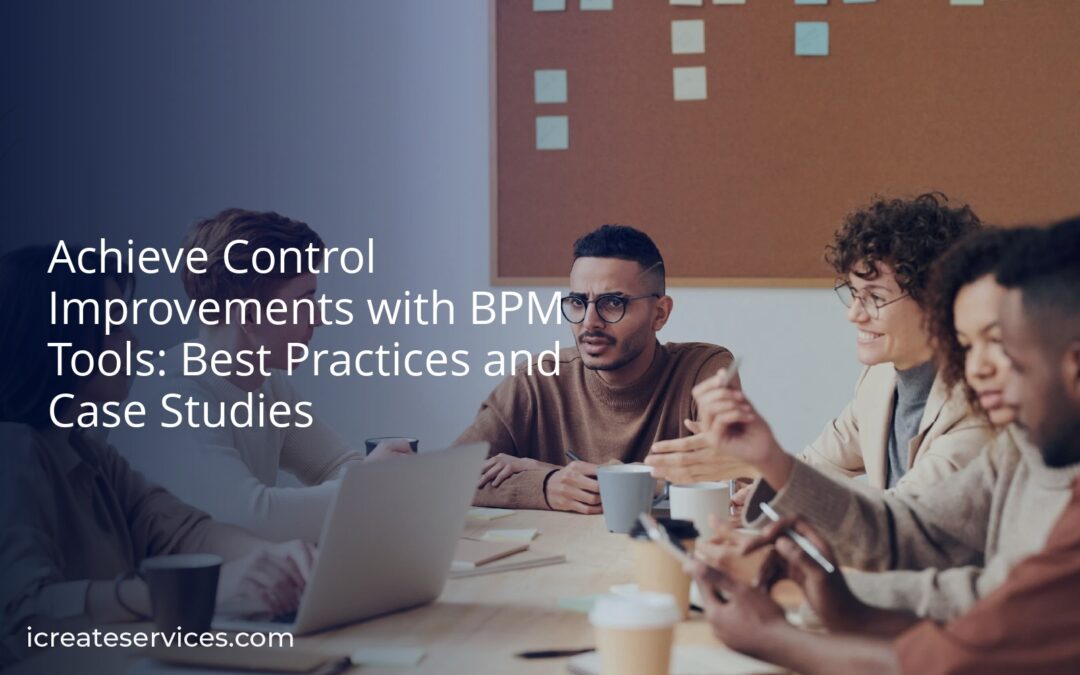Understanding BPM Tools
Business Process Management (BPM) tools are software solutions designed to enhance operational efficiency and control by automating repetitive tasks. These tools simplify complex workflows and enable seamless integration across departments. By using BPM tools, companies can manage business processes effectively, ensuring activities align with organizational goals.
Key Features of BPM Tools
- Process Modeling: This feature allows the visualization of business processes. It simplifies understanding and refining workflows.
- Automation: BPM tools automate repetitive tasks. This reduces human error and increases efficiency.
- Integration: Integration capabilities ensure that various systems can communicate and work together seamlessly.
- Collaboration: These tools foster teamwork by providing a platform for employees to collaborate on projects and tasks.
- Monitoring and Analytics: BPM tools track performance metrics. This helps identify bottlenecks and improve processes.
- Compliance Management: Ensures that business processes adhere to regulatory standards.
Benefits of Implementing BPM Tools
- Efficiency: Processes become quicker and smoother, minimizing delays and redundancies.
- Quality Control: Automating tasks ensures higher consistency and reduces the likelihood of errors.
- Visibility: Enhanced tracking of processes offers deeper insights into operations.
- Agility: Companies can adapt processes swiftly in response to market changes.
- Customer Satisfaction: Improved process quality directly impacts customer experience positively.
Common BPM Tools in the Market
- IBM BPM: Provides comprehensive business process management from process modeling to execution.
- Appian: Focuses on both BPM and case management with low-code development capabilities.
- Pega Systems: Known for its scalability and extensive integration features.
- Bizagi: Combines powerful process modeling and automation features.
- Nintex: Excel in workflow automation and is user-friendly.
Selection Criteria for BPM Tools
- Ease of Use: Intuitive interfaces minimize the learning curve and enhance user adoption.
- Scalability: Tools should grow with the business, supporting increasing complexity.
- Customization: The ability to tailor solutions to specific business needs is paramount.
- Support and Training: Adequate vendor support and training resources ensure successful implementation.
- Integration Capabilities: Ensures compatibility with existing systems for seamless operation.
- Resistance to Change: Employees may resist adopting new tools and processes.
- Integration Issues: Legacy systems may pose compatibility challenges.
- Cost: Initial investment and maintenance costs can be substantial, especially for small businesses.
- Complexity: Implementing and managing BPM tools can be intricate, requiring specialized skills.
BPM tools offer essential capabilities to manage and optimize business processes effectively, driving operational excellence and adaptability in a dynamic business landscape.
Key Features Driving Control Improvements
BPM tools enhance control through essential features, enabling businesses to streamline their processes and respond swiftly to changes.
Task Automation
Task automation reduces manual intervention, minimizing errors and increasing efficiency. By automating repetitive tasks like data entry and notifications, BPM tools free up valuable employee time, allowing staff to focus on more strategic activities. For example, automated approval workflows ensure that processes move quickly without unnecessary delays, enhancing overall productivity.
Real-Time Monitoring
Real-time monitoring provides instant visibility into ongoing processes. BPM tools offer dashboards that track key performance indicators (KPIs), letting managers quickly identify bottlenecks and inefficiencies. If a process deviates from the norm, immediate alerts enable swift corrective actions, maintaining smooth operations. This constant oversight ensures that processes remain aligned with organizational goals.
Performance Analytics
Performance analytics contribute to data-driven decision-making by analyzing process data. BPM tools generate reports and insights on process performance, highlighting areas for improvement. By examining metrics like cycle time and throughput, businesses can uncover inefficiencies and optimize their workflows. This analytical capability supports continuous improvement and enhances overall operational control.
Benefits of BPM Tools for Businesses
Integrating BPM tools into business operations brings numerous benefits. These tools enhance efficiency, ensure compliance, and aid in better decision-making.
Enhanced Efficiency
BPM tools streamline processes by automating repetitive tasks and simplifying complex workflows. Automation minimizes human errors and accelerates task completion. For instance, automated invoice processing speeds up approval times and reduces manual entry errors. Additionally, BPM tools facilitate task prioritization and resource allocation, ensuring optimal use of employee skills and time.
Improved Compliance
Meeting regulatory requirements becomes manageable with BPM tools. These tools integrate compliance checks within workflows, ensuring adherence to industry standards and regulations. For example, audit trails track each change made within a process, providing transparency and accountability. Real-time monitoring and alerts enable us to address potential compliance issues immediately, avoiding penalties and maintaining regulatory standards.
Better Decision Making
Data-driven decision-making improves with BPM tools. Performance analytics gather and analyze process data, identifying trends and areas for improvement. By leveraging dashboards and reports, management gains actionable insights, allowing for strategic planning and optimization. For instance, analyzing customer service processes can unveil patterns leading to increased satisfaction and retention, guiding policy adjustments and resource investments.
Case Studies of BPM Control Improvements
BPM tools significantly improve control across various industries. Let’s explore concrete examples in different sectors to understand their impact better.
Industry-Specific Examples
Healthcare
In the healthcare sector, implementing BPM tools has streamlined patient information management, reducing administrative labor. These tools ensure compliance with regulations like HIPAA by integrating checks directly into processes. For example, a leading hospital reduced patient intake time by 30%, enhancing overall patient satisfaction.
Manufacturing
Manufacturing firms have leveraged BPM tools to optimize production workflows. By automating repetitive tasks, companies have cut down on errors and improved product quality. A notable case involved a manufacturing company that increased production efficiency by 40% through real-time monitoring and timely intervention in the production line.
Financial Services
Financial institutions have benefited from BPM tools by enhancing fraud detection and compliance processes. These tools automate transaction monitoring and flag anomalies. One major bank reduced fraud instances by 25% after integrating BPM tools, which also improved their compliance adherence.
Retail
Retail businesses use BPM tools for inventory management and customer service improvements. Automated inventory tracking and restocking have minimized stockouts and overstock situations. A retail chain reported a 20% increase in inventory turnover rates and a significant improvement in customer satisfaction due to efficient process management.
Telecommunications
Telecommunication companies have optimized customer onboarding and support processes using BPM tools. By automating and monitoring workflows, these companies ensure faster service delivery and reduced customer complaints. For instance, a telecom operator expedited customer onboarding by 50%, resulting in higher customer retention rates.
Insurance
Insurance companies utilize BPM tools to handle claims processing and policy management more efficiently. These tools streamline workflows, ensuring timely processing and reducing operational costs. An insurance firm reported a 35% reduction in claims processing time after BPM tool implementation, leading to enhanced customer trust and satisfaction.
Industry-specific examples demonstrate the broad utility of BPM tools in improving operational control and efficiency, regardless of the sector.
Selecting the Right BPM Tool
Choosing the right Business Process Management (BPM) tool ensures efficient and effective process control. Various factors and options must be assessed to find the best fit.
Criteria for Evaluation
Evaluate BPM tools using key criteria. Consider usability first, ensuring the tool offers an intuitive interface and user-friendly experience. Next, check functionality; the tool should support process modeling, simulation, automation, and monitoring. Integration capabilities come next, allowing the BPM tool to work seamlessly with existing systems like ERP, CRM, and financial software. Scalability is crucial; select a tool that grows with organizational needs. Finally, review cost, making sure it provides value for money with transparent pricing structures.
Popular BPM Tools in the Market
Popular BPM tools range across functionalities and industries. Bizagi stands out for its comprehensive process automation and modeling features. Appian offers low-code development, enabling rapid application deployment. IBM Business Process Manager integrates with AI, enhancing decision-making capabilities. Nintex simplifies workflow automation and is known for its ease of use. Pegasystems supports complex workflows with advanced analytics and AI-driven insights. Kissflow is another user-friendly option, providing a platform for process automation without deep technical knowledge. These tools exemplify the diverse options available to meet various business needs and criteria.
Implementing BPM Tools Successfully
Ensuring the successful implementation of BPM tools involves strategic planning and careful execution. Following best practices and recognizing potential pitfalls enhance project outcomes.
Best Practices
Define Clear Objectives
We must outline specific goals for our BPM implementation. Clear objectives guide the project’s direction and provide benchmarks for success.
Involve Stakeholders
Involving key stakeholders ensures alignment with organizational needs. Their input aids in refining processes and gaining buy-in.
Select the Right BPM Tool
Choosing a BPM tool that suits our organizational needs is crucial. Consider usability, integration capabilities, scalability, and cost.
Provide Adequate Training
We need to invest in comprehensive training for users. Training facilitates smooth adoption and maximizes the tool’s potential.
Monitor and Adjust
Continuous monitoring and adjusting ensure the BPM tool remains effective. We should evaluate performance and make necessary improvements.
Potential Pitfalls to Avoid
Neglecting Stakeholder Engagement
Without stakeholder engagement, projects may fail. We must involve them from the start to ensure alignment and support.
Inadequate Training
Lack of proper training can hinder BPM tool adoption. We need comprehensive training plans for all users.
Overlooking Scalability
If we do not consider scalability, future growth can become challenging. Choose a BPM tool that scales with our business needs.
Ignoring Process Monitoring
Failing to monitor processes reduces effectiveness. Regular evaluations help maintain optimal performance and adaptability.
These practices and pitfalls guide us toward successful BPM tool implementation, optimizing operational efficiency and control.
Conclusion
BPM tools offer a strategic advantage in streamlining operations and driving efficiency. By carefully selecting and implementing the right tool, we can achieve significant control improvements and operational excellence. Engaging stakeholders, providing proper training, and monitoring performance are crucial steps in this journey. Avoiding common pitfalls ensures our BPM initiatives are successful and sustainable. With the right approach, BPM tools can transform our business processes and deliver long-term value.
- Demystifying Fuel Test Procedures and Standards - January 16, 2025
- The Benefits of SAP Invoice Management in Financial Processes - December 4, 2024
- Enterprise Software for Comprehensive Risk Management - July 29, 2024




